Ages & Stages
Questionnaires®
54 51 months 0 days through 56 months 30 days
Month Questionnaire
Please provide the following information. Use black or blue ink only and print legibly when completing this form.
Date ASQ completed:
Child’s information
|
Middle |
|
|
Child’s first name: |
initial: |
Child’s last name: |
|
|
|
|
Child’s gender: |
|
|
|
|
Male |
Female |
Child’s date of birth: |
|
|
|
|
Person filling out questionnaire
|
Middle |
Last name: |
|
|
|
First name: |
initial: |
|
|
|
|
|
Relationship to child: |
|
|
|
|
|
Parent |
Guardian |
Teacher |
Child care |
|
|
provider |
|
|
|
|
|
Street address: |
|
Grandparent |
Foster |
Other: |
|
|
|
or other |
parent |
|
|
|
|
|
|
|
relative |
|
|
|
|
State/ |
ZIP/ |
City: |
Province: |
Postal code: |
|
|
|
|
Home |
Other |
|
telephone |
telephone |
Country: |
number: |
number: |
|
|
|
E-mail address: |
|
|
|
|
|
Names of people assisting in questionnaire completion: |
|
|
|
|
|
|
|
|
Program Information
Child ID #:
Program ID #:
Program name:
P101540100 |
Ages & Stages Questionnaires®, Third Edition (ASQ-3™), Squires & Bricker |
© 2009 Paul H. Brookes Publishing Co. All rights reserved. |
54 Month Questionnaire |
51 months 0 days |
through 56 months 30 days |
On the following pages are questions about activities children may do. Your child may have already done some of the activities described here, and there may be some your child has not begun doing yet. For each item, please fill in the circle that indicates whether your child is doing the activity regularly, sometimes, or not yet.
Important Points to Remember:
✓
❑ Try each activity with your child before marking a response.
✓
❑ Make completing this questionnaire a game that is fun for you and your child.
✓
❑ Make sure your child is rested and fed.
✓
❑ Please return this questionnaire by _______________.
Notes:
____________________________________________
____________________________________________
____________________________________________
____________________________________________
1. Does your child tell you at least two things about common objects? For example, if you say to your child, ÒTell me about your ball,Ó does she say something like, ÒItÕs round. I throw it. ItÕs bigÓ?
2. Does your child use all of the words in a sentence (for example, Òa,Ó Òthe,Ó Òam,Ó Òis,Ó and ÒareÓ) to make complete sentences, such as ÒI am going to the park,Ó ÒIs there a toy to play with?Ó or ÒAre you com- ing, too?Ó
3. Does your child use endings of words, such as Ò-s,Ó Ò-ed,Ó and Ò-ingÓ? For example, does your child say things like, ÒI see two cats,Ó ÒI am playing,Ó or ÒI kicked the ballÓ?
4. Without giving your child help by pointing or repeating directions, does he follow three directions that are unrelated to one another? Give all three directions before your child starts. For example, you may ask your child, ÒClap your hands, walk to the door, and sit down,Ó or ÒGive me the pen, open the book, and stand up.Ó
5. Does your child use four- and five-word sentences? For example, does your child say, ÒI want the carÓ? Please write an example:
6. When talking about something that already happened, does your child use words that end in Ò-ed,Ó such as Òwalked,Ó Òjumped,Ó or ÒplayedÓ? Ask your child questions, such as ÒHow did you get to the store?Ó (ÒWe walked.Ó) ÒWhat did you do at your friendÕs house?Ó (ÒWe played.Ó)
Please write an example:
COMMUNICATION TOTAL
page 2 of 7
E101540200 |
Ages & Stages Questionnaires¨, Third Edition (ASQ-3ª), Squires & Bricker |
© 2009 Paul H. Brookes Publishing Co. All rights reserved. |
54 Month Questionnaire page 3 of 7
1. Does your child hop up and down on either the right foot or the left foot at least one time without losing her balance or falling?
2. While standing, does your child throw a ball OVERHAND in the direction of a person standing at least 6 feet away? To throw overhand, your child must raise his arm to shoulder height and throw the ball forward. (Dropping the ball or throwing the ball underhand should be scored as “not yet.”)
3. Does your child jump forward a distance of 20 inches from a standing position, starting with her feet together?
4. Does your child catch a large ball with both hands? (You should stand about 5 feet away and give your child two or three tries before you mark the answer.)
5. Without holding onto anything, does your child stand on one foot for at least 5 seconds without losing her balance and putting her foot down? (You may give your child two or three tries before you mark the answer.)
6. Does your child walk on his tiptoes for 15 feet (about the length of a large car)? (You may show him how to do this.)
GROSS MOTOR TOTAL
1.Using the shapes below to look at, does your child copy at least three shapes onto a large piece of paper using a pencil, crayon, or pen, with- out tracing? (Your child’s drawings should look similar to the design of the shapes below, but they may be different in size.)
2.Does your child unbutton one or more buttons? Your child may use his own clothing or a doll’s clothing.
3.Does your child color mostly within the lines in a coloring book or within the lines of a 2-inch circle that you draw? (Your child should not go more than 1⁄4 inch outside the lines on most of the picture.)
E101540300 |
Ages & Stages Questionnaires®, Third Edition (ASQ-3™), Squires & Bricker |
© 2009 Paul H. Brookes Publishing Co. All rights reserved. |
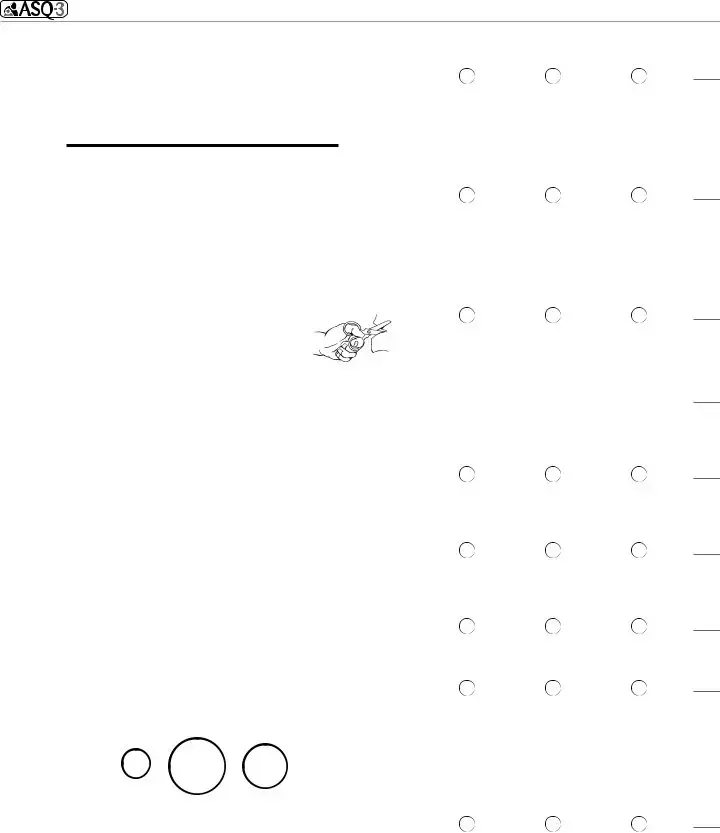
54 Month Questionnaire page 4 of 7
FINE MOTOR (continued) |
YES |
SOMETIMESNOT YET |
4. Ask your child to trace on the line below with a pencil. Does your child trace on the line without going off the line more than two times? (Mark “sometimes” if your child goes off the line three times.)
5. Ask your child to draw a picture of a person on a blank sheet of paper. You may ask your child, “Draw a picture of a girl or a boy.” If your child draws a person with head, body, arms, AND legs, mark “yes.” If your child draws a person with only three parts (head, body, arms, or legs), mark “sometimes.” If your child draws a person with two or fewer parts (head, body, arms, or legs), mark “not yet.” Be sure to include the sheet of paper with your child’s drawing with this questionnaire.
6. Draw a line across a piece of paper. Using child-safe scissors, does your child cut the paper in half on a more or less straight line, making the blades go up and down? (Carefully watch your child’s use of scissors for safety reasons.)
FINE MOTOR TOTAL
1. When shown objects and asked, “What color is this?” does your child name five different colors, like red, blue, yellow, orange, black, white, or pink? (Mark “yes” only if your child answers the question correctly using five colors.)
2. Does your child dress up and “play-act,” pretending to be someone or something else? For example, your child may dress up in different clothes and pretend to be a mommy, daddy, brother, sister, or an imag- inary animal or figure.
3. If you place five objects in front of your child, can she count them by saying, “One, two, three, four, five” in order? (Ask this question WITHOUT providing help by pointing, gesturing, or naming.)
4. When asked, “Which circle is smallest?” does your child point to the smallest circle? (Ask this question WITHOUT providing help by pointing, gesturing, or looking at the smallest circle.)
5. Does your child count up to 15 without making mistakes? If so, mark “yes.” If your child counts to 12 without making mistakes, mark “some- times.”
E101540400 |
Ages & Stages Questionnaires®, Third Edition (ASQ-3™), Squires & Bricker |
© 2009 Paul H. Brookes Publishing Co. All rights reserved. |
54 Month Questionnaire page 5 of 7
PROBLEM SOLVING |
(continued) |
|
YES |
SOMETIMES |
NOT YET |
6. Does your child know the names of numbers? (Mark “yes” if he identi- |
|
|
|
fies the three numbers below. Mark “sometimes” if he identifies two |
|
|
|
numbers.) |
|
|
|
|
|
3 |
1 |
2 |
|
PROBLEM SOLVING TOTAL |
1. Does your child wash her hands using soap and water and dry off with a towel without help?
2. Does your child tell you the names of two or more playmates, not in- cluding brothers and sisters? (Ask this question without providing help by suggesting names of playmates or friends.)
3. Does your child brush his teeth by putting toothpaste on the tooth- brush and brushing all of his teeth without help? (You may still need to
check and rebrush your child’s teeth.)
4. Does your child serve herself, taking food from one container to an- other, using utensils? (For example, does your child use a large spoon to scoop applesauce from a jar into a bowl?)
5. Does your child tell you at least four of the following? Please mark the items your child knows.
a. First name |
d. Last name |
b. Age |
e. Boy or girl |
c. City he lives in |
f. Telephone number |
6. Does your child dress and undress herself, including buttoning medium-size buttons and zipping front zippers?
PERSONAL-SOCIAL TOTAL
OVERALL
Parents and providers may use the space below for additional comments.
1. Do you think your child hears well? If no, explain: |
YES |
NO |
E101540500 |
Ages & Stages Questionnaires®, Third Edition (ASQ-3™), Squires & Bricker |
© 2009 Paul H. Brookes Publishing Co. All rights reserved. |
54 Month Questionnaire page 6 of 7
OVERALL (continued) |
|
|
2. Do you think your child talks like other children her age? If no, explain: |
YES |
NO |
3. Can you understand most of what your child says? If no, explain: |
YES |
NO |
4. Can other people understand most of what your child says? If no, explain: |
YES |
NO |
5. Do you think your child walks, runs, and climbs like other children his age? |
YES |
NO |
If no, explain: |
|
|
6. Does either parent have a family history of childhood deafness or hearing |
YES |
NO |
impairment? If yes, explain: |
|
|
7. Do you have any concerns about your child’s vision? If yes, explain: |
YES |
NO |
E101540600 |
Ages & Stages Questionnaires®, Third Edition (ASQ-3™), Squires & Bricker |
© 2009 Paul H. Brookes Publishing Co. All rights reserved. |
54 Month Questionnaire page 7 of 7
OVERALL (continued) |
|
|
8. Has your child had any medical problems in the last several months? If yes, explain: |
YES |
NO |
9. Do you have any concerns about your child’s behavior? If yes, explain: |
YES |
NO |
10. Does anything about your child worry you? If yes, explain: |
YES |
NO |
E101540700 |
Ages & Stages Questionnaires®, Third Edition (ASQ-3™), Squires & Bricker |
© 2009 Paul H. Brookes Publishing Co. All rights reserved. |
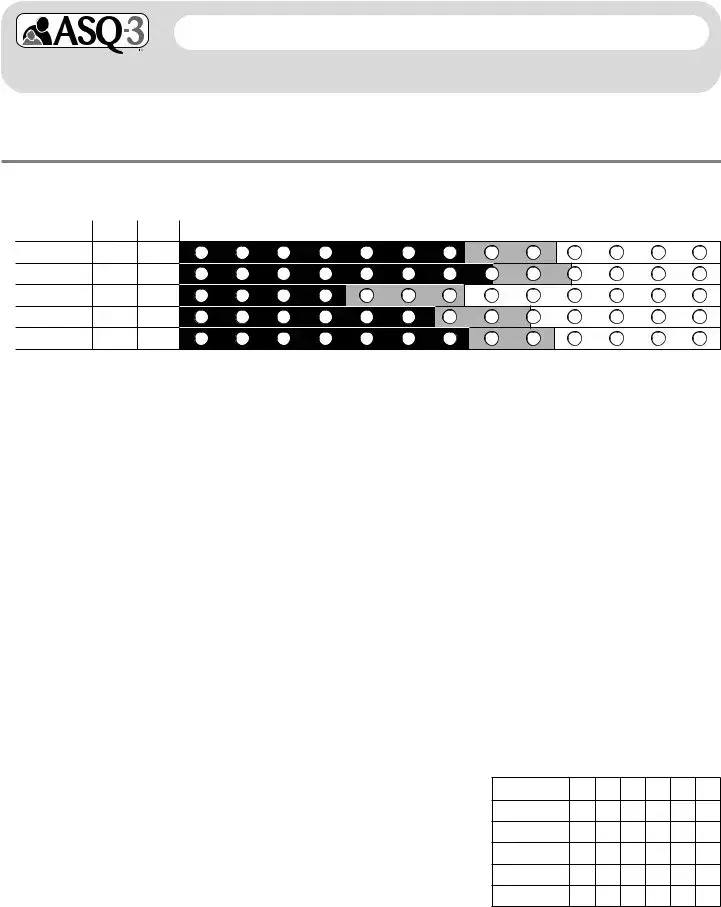
|
54 Month ASQ-3 Information Summary |
51 months 0 days through |
|
56 months 30 days |
|
|
|
|
|
|
Child’s name: ________________________________________________________ |
Date ASQ completed: __________________________________________ |
|
|
|
|
|
|
Child’s ID #: ______________________________________________________ |
Date of birth: ______________________________________________ |
Administering program/provider: |
|
|
|
|
|
1.SCORE AND TRANSFER TOTALS TO CHART BELOW: See ASQ-3 User’s Guide for details, including how to adjust scores if item responses are missing. Score each item (YES = 10, SOMETIMES = 5, NOT YET = 0). Add item scores, and record each area total. In the chart below, transfer the total scores, and fill in the circles corresponding with the total scores.
|
Total |
0 |
5 |
10 |
15 |
20 |
25 |
30 |
35 |
40 |
45 |
50 |
55 |
60 |
Area |
Cutoff Score |
Communication |
31.85 |
|
|
|
|
|
|
|
|
|
|
|
|
|
Gross Motor |
35.18 |
|
|
|
|
|
|
|
|
|
|
|
|
|
Fine Motor |
17.32 |
|
|
|
|
|
|
|
|
|
|
|
|
|
Problem Solving |
28.12 |
|
|
|
|
|
|
|
|
|
|
|
|
|
Personal-Social |
32.33 |
|
|
|
|
|
|
|
|
|
|
|
|
|
2.TRANSFER OVERALL RESPONSES: Bolded uppercase responses require follow-up. See ASQ-3 User’s Guide, Chapter 6.
1. |
Hears well? |
Yes |
NO |
6. |
Family history of hearing impairment? |
YES |
No |
|
Comments: |
|
|
|
Comments: |
|
|
2. |
Talks like other children his age? |
Yes |
NO |
7. |
Concerns about vision? |
YES |
No |
|
Comments: |
|
|
|
Comments: |
|
|
3. |
Understand most of what your child says? |
Yes |
NO |
8. |
Any medical problems? |
YES |
No |
|
Comments: |
|
|
|
Comments: |
|
|
4. |
Others understand most of what your child says? |
Yes |
NO |
9. |
Concerns about behavior? |
YES |
No |
|
Comments: |
|
|
|
Comments: |
|
|
5. |
Walks, runs, and climbs like other children? |
Yes |
NO |
10. |
Other concerns? |
YES |
No |
|
Comments: |
|
|
|
Comments: |
|
|
3.ASQ SCORE INTERPRETATION AND RECOMMENDATION FOR FOLLOW-UP: You must consider total area scores, overall responses, and other considerations, such as opportunities to practice skills, to determine appropriate follow-up.
If the child’s total score is in the If the child’s total score is in the If the child’s total score is in the
4. FOLLOW-UP ACTION TAKEN: Check all that apply.
______ |
Provide activities and rescreen in _____ months. |
______ |
Share results with primary health care provider. |
______ |
Refer for (circle all that apply) hearing, vision, and/or behavioral screening. |
______ |
Refer to primary health care provider or other community agency (specify |
|
reason): __________________________________________________________. |
______ |
Refer to early intervention/early childhood special education. |
______ |
No further action taken at this time |
______ |
Other (specify): ____________________________________________________ |
5.OPTIONAL: Transfer item responses (Y = YES, S = SOMETIMES, N = NOT YET, X = response missing).
Communication
Gross Motor
Fine Motor
Problem Solving
Personal-Social
P101540800 |
Ages & Stages Questionnaires®, Third Edition (ASQ-3™), Squires & Bricker |
© 2009 Paul H. Brookes Publishing Co. All rights reserved. |
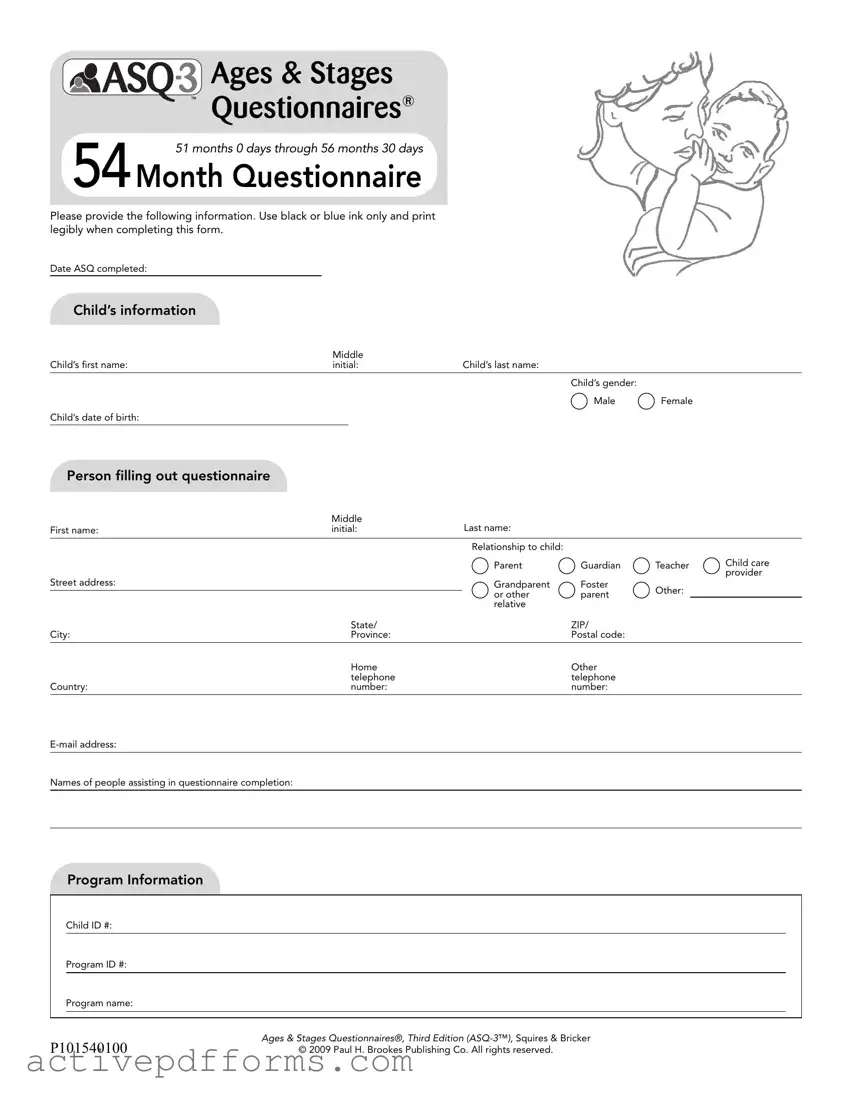
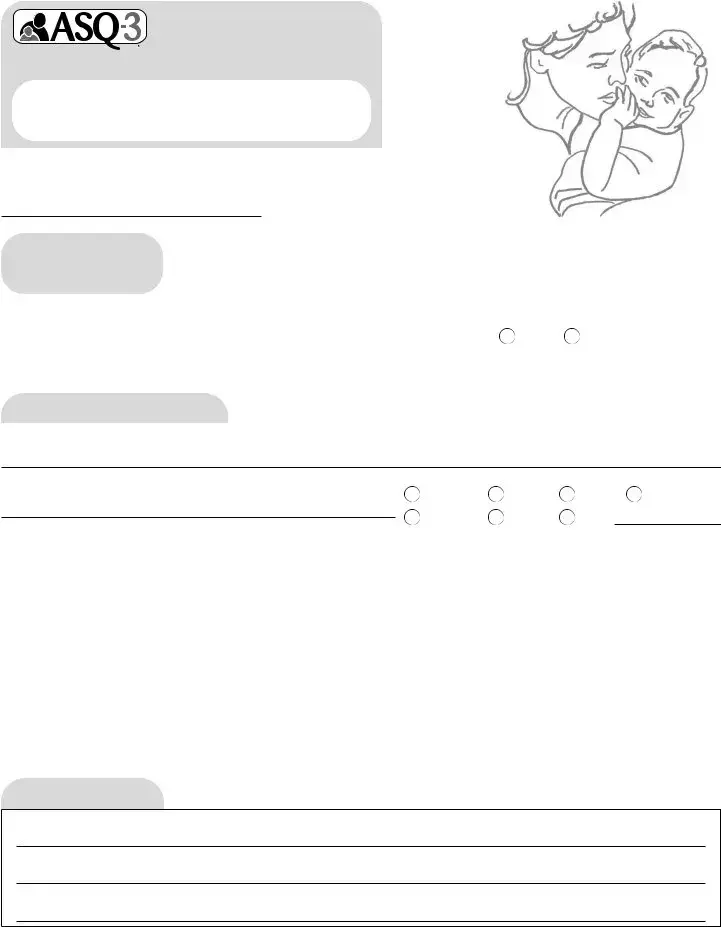
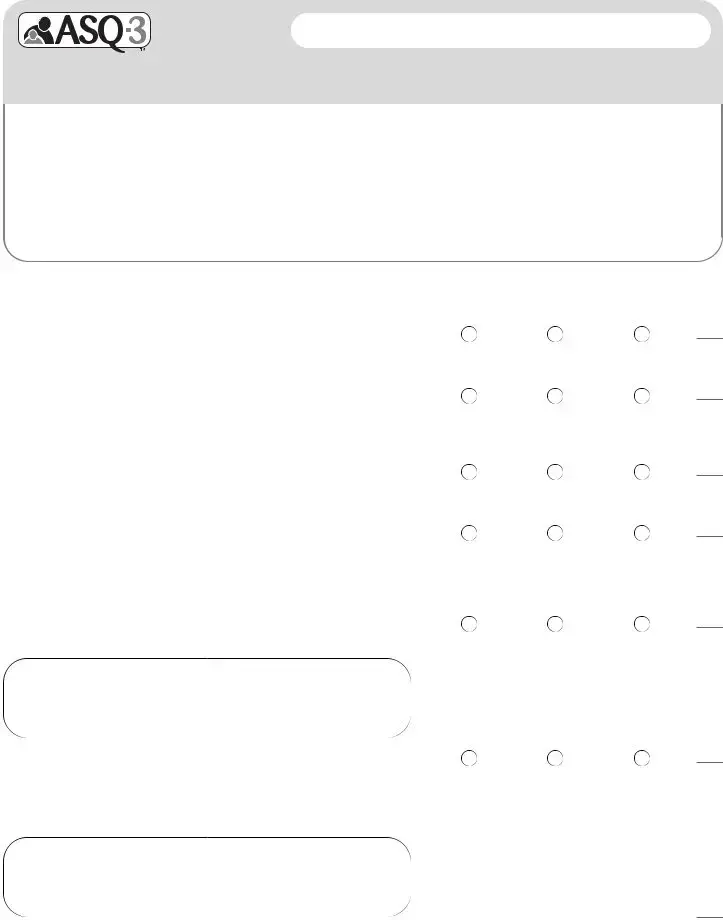
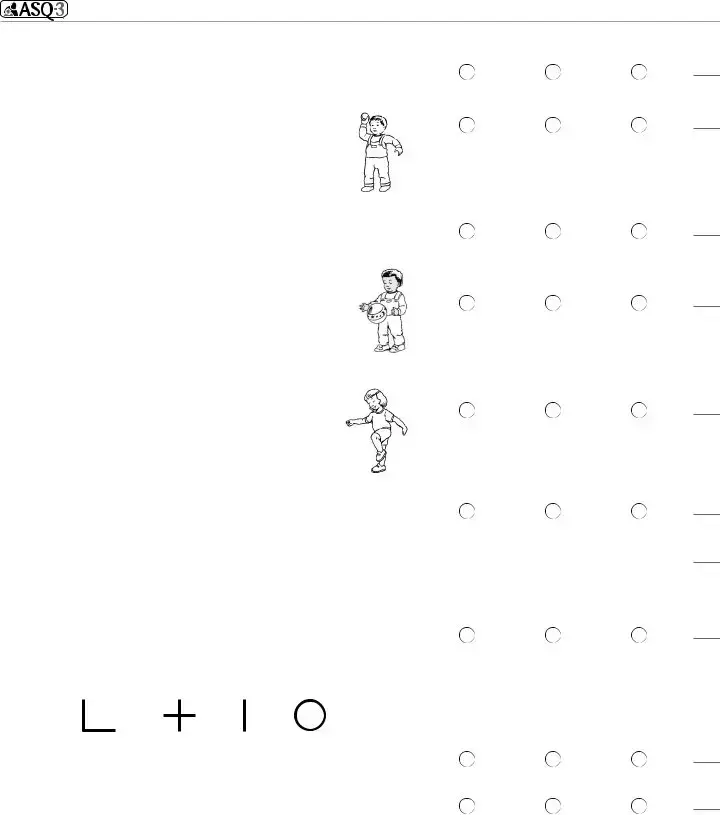

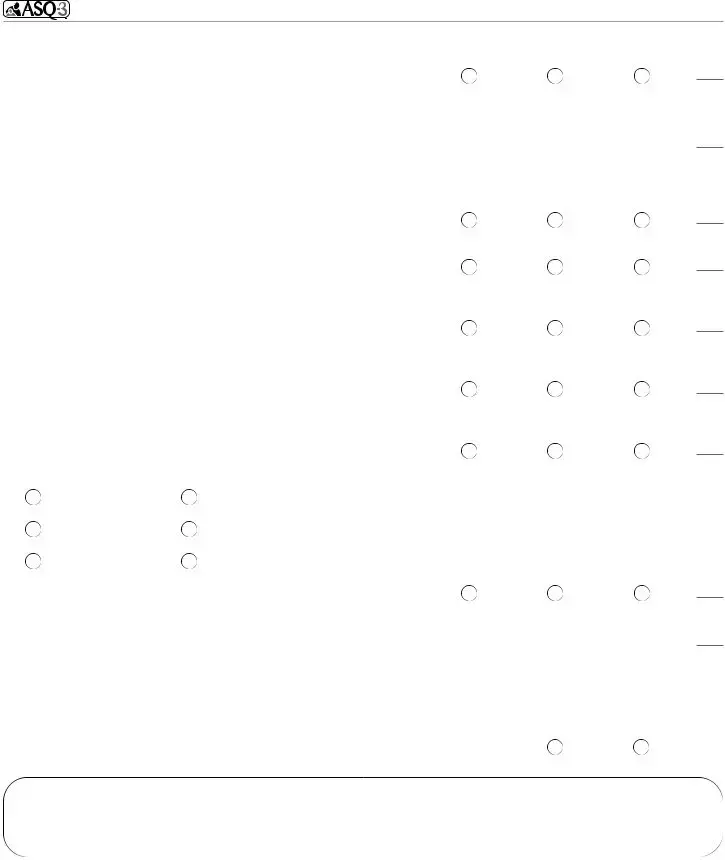
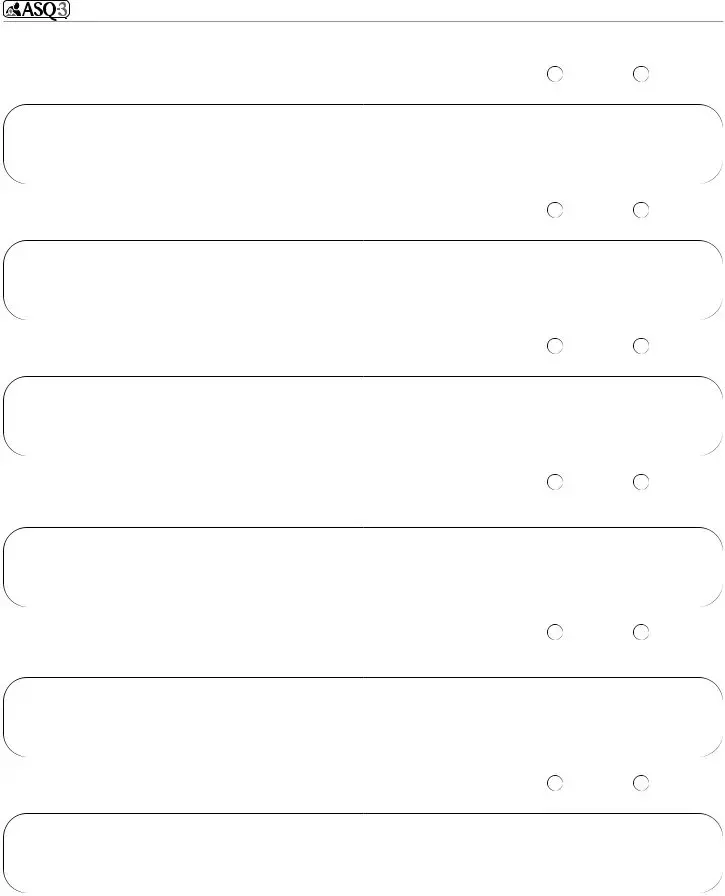
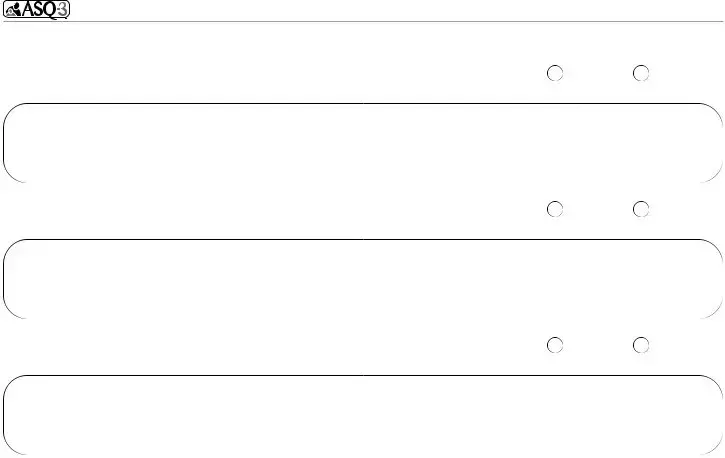


 area, it is above the cutoff, and the child’s development appears to be on schedule.
area, it is above the cutoff, and the child’s development appears to be on schedule.
 area, it is close to the cutoff. Provide learning activities and monitor.
area, it is close to the cutoff. Provide learning activities and monitor.
 area, it is below the cutoff. Further assessment with a professional may be needed.
area, it is below the cutoff. Further assessment with a professional may be needed.